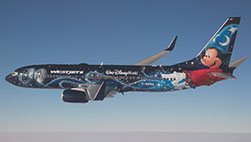by Dale Smith
 Whether you are shaking up a rattle can or yielding a high-end airless spray gun, there’s a lot more to achieving a great paint finish than picking the right color.
Whether you are shaking up a rattle can or yielding a high-end airless spray gun, there’s a lot more to achieving a great paint finish than picking the right color.
The aircraft coatings industry has undergone a revolution of sorts. The old chromate-heavy primers and topcoat-type paints have all but been replaced with the new basecoat/clearcoat formulas.
These new paint formulations are not only much, much more environmentally friendly, the fact that they dry faster and hold their colors years longer on the aircraft, have freed airlines up to use their fleet as airborne billboards touting everything from elaborate liveries to some really creative, co-branding messaging.
“For these purposes, the paint performs a very special role,” stated Stefan Jaschinski, head of Technical Services for Mankiewicz Coatings. “The applications of complex liveries and the usage of micas have increased over the past years. The quickness (drying times) of the basecoat applications plays an important role here.”
“For instance, if one were to paint the WestJet Disney livery using topcoats, the aircraft would sit in the hangar for weeks without being able to carry passengers,” he said. “That is inconceivable.”
According to Mankiewicz, the Disney Magic themed 737 the company painted for Canadian Airline WestJet required 36 color shades partially achieved by the company’s “wild spraying technique” which is based on the blending and shading of various colors.
“The wild spraying technique is one of the many process improvements that accompany the basecoat/clearcoat technology,” Jaschinski said. “Instead of the most frequent color (base color) being applied first, you can apply the lowest (background) color first. Amongst time and material, this procedure results in weight and cost savings for the operator.”
“The overwhelming perception is that the basecoat/clearcoat technology potentially adds two to three years to the life of an aircraft’s finish,” explained Richard Giles, Global Technical Service and Training Manager, Sherwin-Williams Aerospace Coatings. “That’s many more years on the strip cycle and that adds up to significant savings, which airlines are using to invest in more aesthetically pleasing livery.” Of course, whether you’re painting a simple white fuselage with red and blue stripes or WestJet’s elaborate Disney Frozen themed livery, the successful application of basecoat/clearcoat paints requires a fundamental rethink of your painting processes. And that requires training. For example, Désiree Oldenburger, AkzoNobel Aerospace Coating’s, segment manager, explained that the company not only offers training for aircraft coatings technicians, they also offer training for livery designers.
“Designers often use different color standards (PMS color std.) as used within the aerospace industry. AkzoNobel set up a dedicated color design studio to assist the artist in developing the new color livery for the aircraft,” she said. “Specially trained people can guide the designer on the realistic options and systems for the exterior application on an aircraft. This initiative is taken to speed up the process from the designer’s drawing board to the aircraft on the runway.”